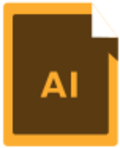Artwork Guidelines
Before uploading artwork, please note the following:
Accepted File Forms

Vector Images
Resolution independent images using points, lines & shapes that can be resized without loss of quality.

Raster Images
Resolution dependent images that use a grid of small dots & lose quality when resized.

Adobe PDF
(preferred)

Adobe Illustrator

Encapsulated PostScript

SVG File

Adobe Photoshop

TIFF File

JPEG File

PNG File




CMYK is a subtractive 4-color printing process that used cyan, magenta, yellow & black inks. It is subtractive since light is reflected off the paper.



RGB is an additive light-based color used for computer monitors that includes red, green & blue. It is additive since direct light is used to display color.
If available, save your artwork as a high-resolution Adobe PDF with Press Quality selected to avoid poor print quality. PDF is an open format, and some PDF elements are not printable. We suggest applying PDF/X to ensure all elements of your art file can be printed.
Word processors, spreadsheets, presentations, PDF readers and rudimentary image editing programs are not the ideal choice for editing or creating graphics. Also, we do not recommend using Adobe Reader to edit your PDF files. Use our free professional online design software or applications like Adobe Creative Suite, CorelDraw or QuarkXPress to export an Adobe PDF with Press Quality.
Finding the Correct Label Size
Before ordering your labels, if you need help finding the correct label size we have several options to help you find the proper fit. Read How to Choose the Correct Label Size to see how easy it is to find the right label.
If you have any questions regarding setting up your artwork or selecting the right file types, please call our Client Services Department at (800) 942-8379 to help guide you.
File Requirements

Your fonts must be embedded. If you're not sure, convert your text to outline before uploading your artwork to avoid delays. If converted to an image, pixel-based typesetting of 800dpi is suggested.
JPEG, PNG, BMP and other non-copyright images taken from the internet may include settings or artifacts that interfere with print quality. A higher resolution may help. For these and grayscale images, a minimum 600dpi is suggested.
Color Palette

We accept RGB and CMYK color palettes. We print in 4-color GRACol. Other gamuts or color profiles are converted before printing. PANTONE (PMS) colors are printed in their closest CMYK color.
Artwork Colors

We accept both CMYK and RGB color palettes, however, we highly recommend art files be submitted in CMYK for best printing results. Files submitted in RGB will have to be converted in-house to CMYK, and the color difference can be quite dramatic, especially for bright colors.


What’s the difference?
CMYK stands for cyan, magenta, yellow and black (also called “key”). RGB stands for red, green and blue. While both methods offer a wide range of colours, there are fundamental differences in how they are created. CMYK is the industry standard for professionally printed materials, as RGB colours can appear dull or faded when printed. RGB is best for computer monitors, devices, cameras and light-based technology.
Since most of today’s image-editing programs use RGB as the standard default, make sure your color settings are set to CMYK before you begin designing for the best printing results. If using a graphic designer, let them know you’ll need your artwork delivered in CMYK.
CMYK Image (Print Use)

CMYK colors are the industry standard for printed materials and produce truer, more accurate color matching.
RGB Image (Digital/Web Use)

RGB colors are used when designing for light-based technology such as computer monitors, mobile devices and televisions.
File Layout

Trim Line
The trim line is where your label or card will be cut. This is the finished size. To position your art file to the finished size, the trim line may be identified as a spot colour named DIELINE in your art file. The trim line must match the size you selected. A better option is to use our online design software to position your art correctly.
Many factors (art file, label size & material properties) affect the final trim size. So make sure to use bleed margins to print to the edge, and safety margins to fit your art.
Bleed Line
Include 1/16" space outside the dimensions (on each side of the trim line) as the bleed area. Any background colour or graphic that you want printed to the edge of your label should extend to the bleed line to ensure the final product has no gaps. The bleed line can be defined as a spot color named BLEEDLINE in your art file.
Safety Line
Include 1/16" space inside the dimensions (on each side of the trim line) as a safe area. Text & graphics should be inside the safety line to ensure they're not cut off. The safety line can be defined as a spot color named SAFELINE.
Electronic Proofs
Free Electronic Proofs
A free electronic proof is the best option for reviewing your custom printed orders. For sheet labels and cards, you will be asked to download your electronic proof.
Colors on computer screens vary from device to device. As a result, electronic proofs provide a good approximation of color but are not an exact color match to printed products. Do not expect printing to produce the same bright colors as seen on your screen.
Validate your login